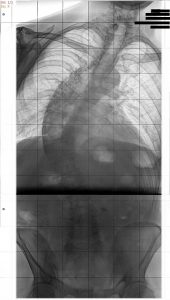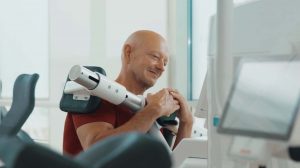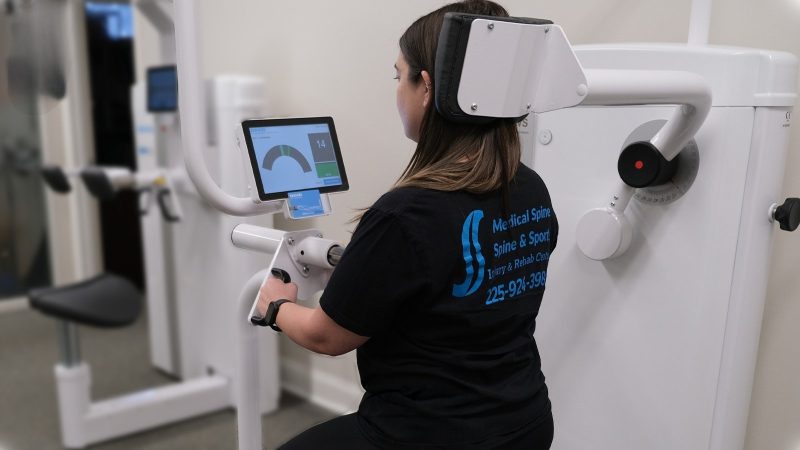What does scoliosis mean in real life?
Scoliosis – a lateral curvature of the spine, is often the most visible spinal deformity, especially in its severe forms. Our patient is a 54-year old male, father and an ex-police officer with two dogs and a bright mind. His back had never been operated on, but different treatment methods and guidelines throughout the years have been used. Due to his own eager interest towards exercise and rehabilitation he managed continue in field work until 2016, after which he had to transfer to office work.
The patient’s spine curves to the right side with one main curve in thoracolumbalis region, ribs protruding on one side, pelvis tilted laterally, shoulder dropped on the left side, muscles on the right side weaker. This „66 degree (Cobb angle) scoliosis thoracolumbalis idiopathica gravis“ does have its visible effects.
The idiopathic scoliosis greatly affected his everyday life. His walking distance varied from a few meters to maximum of 500 meters.
Since the beginning of this year, he is entitled to disability pension. In addition to (or despite of) the structural scoliosis he has been diagnosed with severe deterioration of intervertebral discs, nerve tissue damage on arms and legs, rotator cuff disease on left shoulder and severe arthritis of left hip. His tailbone has straightened which makes sitting uncomfortable and causes neural pain. Due to these factors he also has numbness on his left leg and cramps to both arms and legs. His Oswestry disability index was 52.0 meaning severe disability. The idiopathic scoliosis greatly affected his everyday life. Walking distance varied from a few meters to maximum of 500 meters, depending on the day. During the past few years his condition has decreased rapidly, and he has lost weight of over 10 kilos.
 Front view of the spine of our 54-year old male patient.
Front view of the spine of our 54-year old male patient.
Treatment pathway with the David Solution
We first met him in March 2018. As with every new physiotherapy client, the process started with an evaluation and setting up the goal of the treatment program. The physiotherapist and patient agreed that the goal is to make everyday life easier by improving the functional capacity and slowing down the disadvantage changes within the body. Mobility and isometric strength tests for thoracolumbar spine were carried out with DAVID devices in all directions (flexion, extension, lateral flexion and rotation). Handgrip strength was also tested.
The results clearly showed that the mobility was restricted to all directions especially in rotation and lateral flexion. Overall strength levels were weak and there was a great imbalance between right and left in muscle strength, right being weaker by almost 40 percent. Based on the test results, an individual exercise program was created, where starting weights and range of motion values were defined as percentages from test values. The exercise program was phase-based. This means the weights and range of motion would increase slowly, but gradually.
The mobility was restricted to all directions especially in rotation and lateral flexion. Overall strength levels were weak and there was a great imbalance between right and left in muscle strength, right being weaker by almost 40 percent.
 Our patient exercising in a lateral flexion device (David G150).
Our patient exercising in a lateral flexion device (David G150).
Why we did what we did?
When treating a scoliosis patient it is important to put the focus on the weaker side and not to let the stronger side lead the way. As we know, the body has an ability to balance itself and find ways to compensate the movement. We aim for the upright position and if the spine has a deformity such as scoliosis, elongated and weak muscles have their counterpart in short and strong muscles. Therefore the crucial point in rehabilitation is to try to balance things out and teach the body correct movement patterns. In order to achieve this, we need to be precise in our exercises and control the movement.
The devices allow a patient to follow a precise and pain-free exercise range of motion.
For this case, we exercised the weaker side (in rotation and lateral flexion) with heavier weights compared to the stronger side. Starting weights were 2,5 kilos. DAVID devices allow a patient to follow a precise and pain free exercise range of motion. Therefore we were able to set the range of motion so that the percental values from the test results were higher on the weaker side to stress it slightly more. The EVE software provides real-time guidance for the exercise, the range of motion values and guidance for the speed. Biomechanically optimized devices with correct resistance curves make it possible to complete the exercise safely and in a controlled manner from start to finish. Actively controlled sets were performed with coherent high quality repetitions.
In addition to the device exercises, some additional exercises, stretches and core activation movements, were assigned to him. The device based program was designed to be carried out twice a week and the patient was able to exercise with the devices on his own.
What do the patient’s results tell us?
Follow-up tests were conducted at week 9 and 20 from the initial tests. The improvement in test results has been astonishing.
Long pain phases have decreased, he is able to walk up to five kilometers at a time and is able to put his socks on just by leaning forward.
Both mobility and strength levels increased by more than 100 %. Handgrip strength test values on his weaker (left) hand increased from 1 kg to 50 kg. Numeric values do tell a great success story, but more than anything, he has felt that his quality of life has improved. The Oswestry disability index now shows 40.0 (moderate disability), which is a decrease of 12 points from the initial score. In addition, long pain phases have decreased. In fact, the patient is able to walk up to five kilometers at a time. He is also now able to put his socks on just by leaning forward. Simple, but oh so valuable improvements in a patient’s quality of life.

We are not dealing with an „issue“ which will vanish completely by miracle. What we have found is a way of exercising that gives repeatable quality. It provides great results on measurable indicators on a personal level. One thing I can’t emphasize enough is the power of a patient’s persistence and dedication to rehabilitation, like our police officer has proven. Good results give motivation to continue the lifelong journey towards a healthy body and mind. Being precise definitely has its upside.
 Deutsch
Deutsch 
























